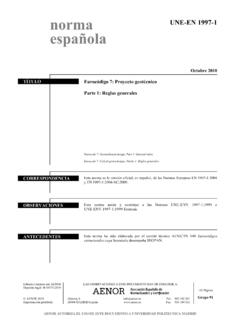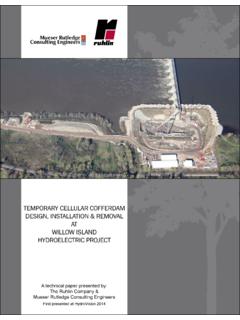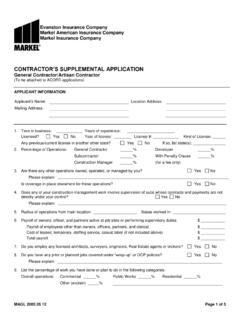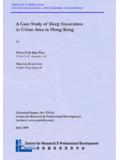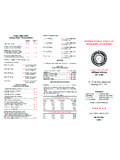Transcription of Earth retaining structures - tocasa.es
1 BRITISH STANDARDBS 8002:1994 Incorporating Amendments Nos. 1 and 2 and Corrigendum No. 1 Code of practice forEarth retaining structuresICS COPYING WITHOUT BSI PERMISSION EXCEPT AS PERMITTED BY COPYRIGHT LAWBS 8002:1994 This British Standard, having been prepared under the direction of the Technical Sector Board for Building and Civil Engineering (B/-), was published under the authority of the Standards Board and comes into effect on15 April 1994 BSI 12 September 2001 The following BSI references relate to the work on this standard.
2 Committee reference B/526 Draft for comment 87/14383 DCISBN 0 580 22826 6 Committees responsible for this British StandardThe preparation of this British Standard was entrusted by the Technical Sector Board for Building and Civil Engineering (B/-) to Technical Committee B/526, upon which the following bodies were represented:Association of Consulting EngineersAssociation of Geotechnical SpecialistsDepartment of the Environment (Construction Directorate)Department of TransportFederation of Civil Engineering ContractorsFederation of Piling SpecialistsInstitution of Civil EngineersInstitution of Structural EngineersAmendments issued since publicationAmd.
3 199512062 May 2001 Indicated by a sideline in the margin13386 Corr. No. 112 September 2001 Figures to replacedBS 8002:1994 BSI 12 September 2001iContentsPageCommittees responsibleInside front coverForewordvSection 1. and types of of type5 Section 2. Data for and geotechnical tides and and evaluation of soil parameter friction, base friction and undrained wall applied loads17 Section 3. Design philosophy, design method and Earth state limit limit states and compatibility of values of soil Earth based on total and effective stress using total stress using effective stress values of wall friction, base friction and undrainedwall adhesion 27BS 8002:1994ii BSI 12 September to structural Earth Earth to Earth pressures and seepage forces41 Section 4.
4 Design of specific Earth retaining of section 3 and section concrete retaining masonry retaining concrete and reinforced masonry walls onspread foundations concrete walls (other than basement walls) walls, excavation, support and retention and prestressed masonry retaining of wall and sheet sheet and prestressed concrete sheet situ concrete pile excavations and , ties, walings and 8002:1994 BSI 12 September structures and A (normative) Graphs for Ka and Kp114 Annex B (informative) Traditional design methods for embedded walls122 Annex C (informative)
5 Bibliography125 Index129 Figure 1 Strength envelopes for a given pre-consolidation12 Figure 2 Derivation of N from SPT value N 16 Figure 3 Limit states for Earth retaining structures20 Figure 4 Pressure diagrams25 Figure 5 Graphical determination of active Earth pressure forcohesionless soils30 Figure 6 Graphical determination of active Earth pressure forcohesive soils33 Figure 7 Construction of Earth pressure diagrams for Earth retaining structures in multi-layered soil35 Figure 8 Flow net determination of pore water pressure36 Figure 9 Linear variation in hydraulic head37 Figure 10 Graded filter drain38 Figure 11 Foundations of gravity walls45 Figure 12 Basic forms of mass concrete walls46 Figure 13 Masonry clad mass concrete wall with cavity48 Figure 14 Stepped and buttressed retaining walls inunreinforced masonry50 Figure 15 Hexagonal woven mesh gabion cage (typical)53 Figure 16 Welded mesh gabion cage (typical)
6 54 Figure 17 Examples of gabion retaining walls57 Figure 18 Section and elevation of typical crib wall58 Figure 19 Examples of timber cribwork59 Figure 20 Examples of reinforced concrete cribwork60 Figure 21 Further examples of reinforced concrete cribwork61 Figure 22 Basic forms of reinforced concrete cantilever or stem wall64 Figure 23 Basic forms of reinforced concrete counterfort andbuttressed walls65 Figure 24 Temporary support against central dumping68 Figure 25 Temporary support by fully braced trench68 Figure 26 Long flying shores across excavations69 Figure 27 Fully braced temporary support69 Figure 28 Concurrent upward and downward construction70 Figure 29 Floors cast on ground with excavation continuing below71 Figure 30 Open cut72 Figure 31 Reinforced masonry: grouted-cavity construction73 Figure 32 Reinforced masonry: Quetta bond construction74 Figure 33 Reinforced masonry: pocket-type construction74BS 8002.
7 1994iv BSI 12 September 2001 PageFigure 34 Reinforced hollow blockwork construction75 Figure 35 Post-tensioned masonry diaphragm wall construction76 Figure 36 Types of embedded retaining wall79 Figure 37 Active pressure diagrams relating to maximum strut loads in braced Earth retaining structures 80 Figure 38 Illustration of method of calculation of bending moments and frame loads by successive stage analysis in cofferdams81 Figure 39 Typical sections of timber sheet piles87 Figure 40 Detail of driving edge87 Figure 41 Horizontal sheeting (lagging)92 Figure 42 Vertical sheeting (lagging)92 Figure 43 Composite steel soldier piles93 Figure 44 Various methods of locating the sheeting (lagging)94 Figure 45 Cofferdam for river crossing96 Figure 46 Cofferdam in water97 Figure 47 Types of cellular cofferdams103 Figure 48 Types of anchorage106 Figure 49 Non-interference of zones for anchored wall107 Figure 50 Double wall construction where zones interfere108 Figure Active pressure Horizontal ground surface behind wall.
8 Values of Ka (horizontal component)114 Figure Passive pressure Horizontal ground surface behind wall: Values of Kp (horizontal component)115 Figure Active pressure Sloping ground surface behind wall: Values ofKa (horizontal component) (based on Kerisel and Absi, 1990)116 Figure Active pressure Sloping ground surface behind wall: Values ofKa (horizontal component) (based on Kerisel and Absi, 1990)117 Figure Active pressure Sloping ground surface behind wall: Values ofKa (horizontal component) (based on Kerisel and Absi, 1990)118 Figure Passive resistance Sloping ground surface behind wall: Values of Kp (horizontal component)119 Figure Passive resistance Sloping ground surface behind wall: Values of Kp (horizontal component)120 Figure Passive resistance Sloping ground surface behind wall.
9 Values of Kp (horizontal component)121 Figure Different methods of assessing the ratio of restoring moments to overturning moments123 Table 1 Unit weights of soils (and similar materials)9 Table 2 crit for clay soils11 Table 3 for siliceous sands and gravels14 Table 4 for rock14 Table 5 Selection of pile size to suit driving conditions in granular soils using impact hammers83 Table 6 Selection of pile size to suit driving conditions in cohesive soils84 List of references132BS 8002:1994 BSI 12 September 2001vForewordBS 8002 has been prepared under the direction of the Technical Sector Board for Building and Civil code of practice is a complete revision of the Civil Engineering Code of Practice No.
10 2, which was issued by the Institution of Structural Engineers in 1951 on behalf of the Civil Engineering Codes of Practice Joint draft of this code of practice, was issued in 1988 for public comment and in 1992 a new committee reviewed and revised the main changes in the design of Earth retaining structures in this code of practice are:a) the recognition that effective stress analysis is the main basis for the assessment of Earth pressures with total (undrained) stress analysis being important for some walls during or immediately following construction;b) the need to take account of the effect of movement (or lack of it) upon the resulting Earth pressures on the wall.

